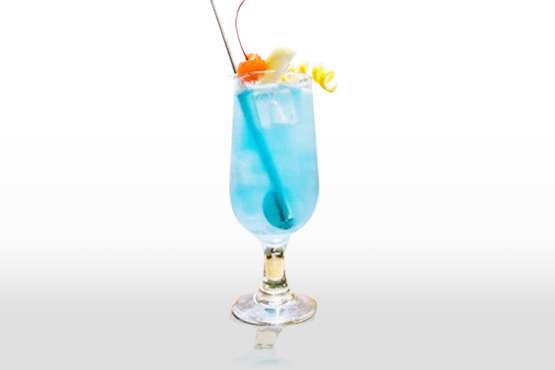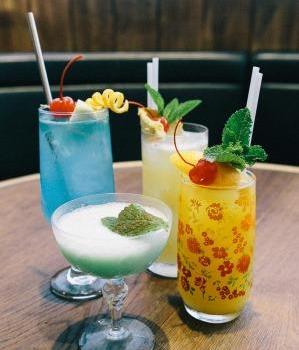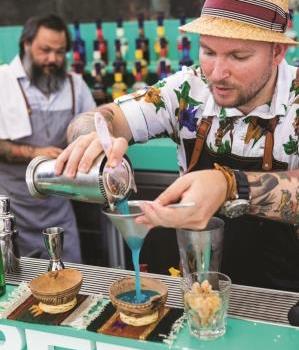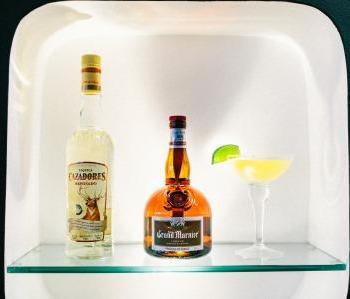Feeling blue? You’re not alone. Bartenders from all across the globe have started to embrace those neon drinks from the 1970s and 80s that time (and common sense) nearly forgot.
Bartenders all across the globe are doing what would have been unthinkable 10 years ago. They’re making – and liking – blue drinks.
The charge has been led by New Zealand’s Jacob Briars and the UK’s Jake Burger, who can’t resist an opportunity to turn a perfectly naturally-coloured drink, well, blue.
Briars kick-started the trend on an international level, when he created the Corpse Reviver Number Blue, a comic twist on the Corpse Reviver Number Two.
All very amusing. But then in 2012 Briars, Philip Duff and Sebastian Reaburn hosted a seminar on blue drinks at Tales of the Cocktail, thereby giving blue drinks an air of academic respectability. Meanwhile The Artesian, that swish and venerated bar in the Langham Hotel in London, put a Blue Lagoon on its menu. Five star hotel approval was bestowed.
In fact, the Artesian introduced an entire section paying homage to disco drinks, including twists on a Rum Runner and Sex on the Beach. Its current menu features a version of the Banana Daiquiri called How Do You Say Banana Daiquiri?
In other words, the bar voted best in the world no less than three times, has embraced all those kitsch drinks many of us thought had been permanently filed away under ‘E’ for embarrassing or ‘N’ for naff.
So what’s going on?
The answer is simple: it’s fun.
“What do you think when you see a blue drink? It puts a smile on your face,” says Arno van Eijmeren, global brand ambassador for De Kuyper, which makes one of the bluest blue curaçaos on the planet. “I believe that’s one of the key things: making drinks fun again, especially with all the terrible news in the world.”
In many ways the blue drink phenomenon feels like an extension of the trend for Tiki drinks: the cocktails are fun, they’re vibrant, they have colourful names. The difference is that drinks such as the Mai Tai and the Zombie have never been far from a good bar’s classic cocktail menu; whereas disco drinks, especially blue drinks, have long been in the wilderness. If you liked them, you’d never admit to it. A bit like Wham! or tofu.
But the cocktail pariah is coming in from the cold, thanks to bars like The Artesian and the short-lived but critically-acclaimed New York venue Golden Cadillac, which used modern bartending techniques to add sophistication to Long Island Iced Teas, Harvey Wallbangers and Tequila Sunrises.
Making horrible drinks better
On Australian shores the revival of disco drinks has yet to fully take root. But you’ll find it in pockets. Charlie Ainsbury, from Sydney’s This Must Be The Place, says he’s been making lots of Grasshoppers lately.
“Some of the drinks from that time were horrible,” Ainsbury explains. “But some of them, like the Grasshopper, have a formula that works. Mint and chocolate go together. You add good liqueurs, fresh fruit and the know-how we have now and they can be great drinks. Just like a Piña Colada. Most of those are horrible when you’re using canned pineapple and all that kind of stuff.
“In terms of disco drinks being a revival, it’s more about plugging the knowledge we have now into the formula.”
As Ainsbury suggests, the 1970s and 80s were not decades of high quality craftsmanship when it came to drinks. Hospitality had an even more transient workforce than it does now. There was little in the way of training. Fresh produce was rarely found behind the bar. Juice was something you got from a can.
Russ McFadden, bar manager at Gazebo in Sydney, describes it as an age of “commercialisation and mass production” when “everything was designed to last longer”. It followed the Second World War and Vietnam. Food was tinned; liquid was pasteurised.
“It was a bit of a nail in the coffin for some of the really great cocktails that were around,” McFadden says.
It wasn’t until the late 1990s and early 2000s that fresh ingredients started to find their way back into bars in any meaningful way. “It makes sense that around about now, where we are, we can look at the kitsch drinks from the 1970s and 80s and ask, ‘What can we do to make this drink better? What can we do to make it fun for consumers? What can we do so it’s not actually a horrible type-two diabetes-inducing beverage?’” McFadden says.
The fun of the fare
As a proper revival, he thinks disco drinks have yet to have their time. “They’re starting to hit the mainstream, certainly in the US and certainly in London. But I think they’ve been a little more difficult for bartenders to really get to grips with. The kind of classic drinks that were revived in bars like Milk & Honey – bartenders love them because they’re spirit based. They can get really nerdy over the liqueurs and spirits that nobody’s really come across. They can hand chip their ice. They can buy fancy, Japanese bar tools. They can make drinks that only bartenders want to drink.”
Which brings us back to fun. The modern cocktail revolution has been terrific in terms of increasing the quality of drinks and the variety of spirits and liqueurs available. In that sense, customers have never had it so good. But there are times when bartending can get too nerdy and too introspective, when bartenders forget about customer enjoyment.
“The whole prohibition, speakeasy trend is great,” says McFadden. “Those bars are great places to go for a date or if you want to have a late night drink. But in some of those bars you almost get told off for wearing the wrong thing, for talking too loudly or for choosing the wrong drink. At the end of the day, most people go out because they want to have fun.”
That’s something that Australia tends to do well. Maybe it’s the innate hospitality of Australians but bars like Hello Sailor in Sydney, The Anchor in Bondi, The Kodiak and Black Pearl in Melbourne are characterised by fun. “You can go and get great drinks in all of them, but they’re really good, fun, party bars,” says McFadden.
That makes disco drinks such a natural fit for Australian venues. Unlike some other classic cocktails, they don’t demand to be taken too seriously. They’re party drinks. They’re designed to put a smile on your face and a twinkle in your eye.
Will they take off again in Australia? Are we likely to see Harvey Wallbangers gracing the menus of the country’s finest watering-holes?
“I don’t see any reason why there won’t be a lot of twists on that style of drink,” says McFadden. “I think it’s entirely possible.”



